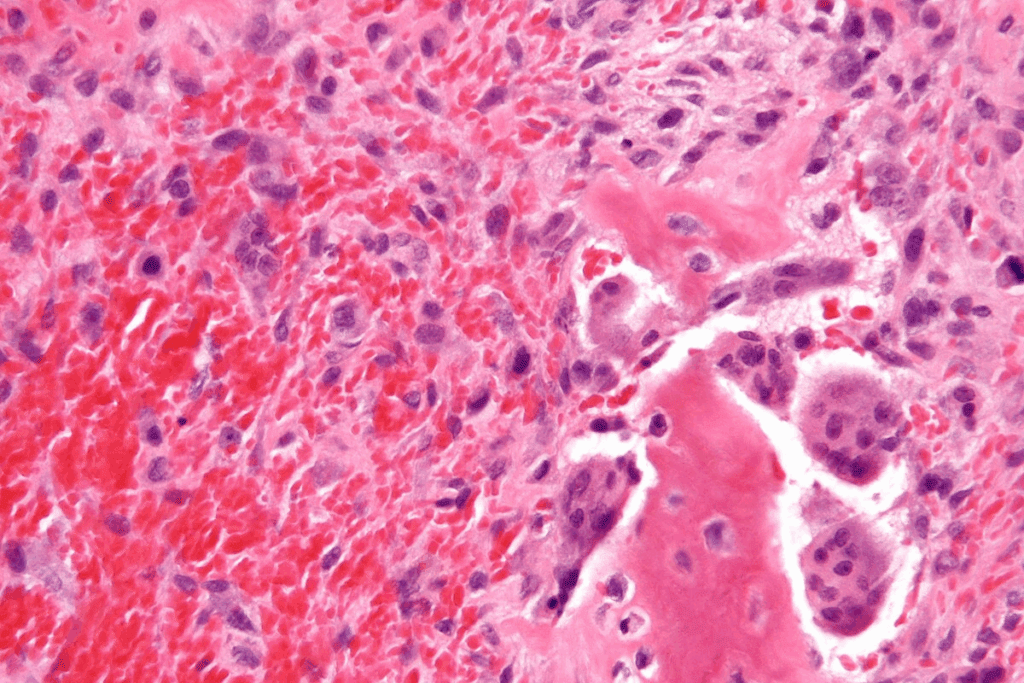Last Updated on November 6, 2025 by Bilal Hasdemir

Chemotherapy is key in treating bladder cancer at all stages. The stage of cancer found at diagnosis helps decide how to treat it. We focus on chemotherapy plans backed by evidence to meet patient needs. Explore 5 essential chemo drugs for bladder cancer treatment. Learn about these options and how they are used in chemotherapy regimens.
There are several FDA-approved chemotherapy choices. Each has its own benefits based on the cancer type and the patient’s health. Knowing these options helps patients and doctors choose the best care.

Bladder cancer is a complex disease. It needs a deep understanding of its types and stages for the best treatment. Knowing how the disease’s characteristics affect treatment is key.
Bladder cancer is mainly split into two types: non-muscle invasive bladder cancer (NMIBC) and muscle-invasive bladder cancer (MIBC). NMIBC stays in the bladder’s inner lining. MIBC has spread to the muscle layer, making it more serious. The stage of bladder cancer shows how far it has spread. Knowing this is important for choosing the right treatment.
Treatment for bladder cancer varies based on the disease’s type and stage. Options include intravesical therapy, where medicine is put directly into the bladder. For more serious cases, systemic chemotherapy is used. Surgery, like transurethral resection of bladder tumor (TURBT) and radical cystectomy, is also a key part of treatment.
Chemotherapy is a key part of bladder cancer treatment, mainly for muscle-invasive or advanced disease. Chemotherapy in bladder cancer can be used before surgery to shrink tumors. It can also be used after surgery to kill any remaining cancer cells. Or, it can be the main treatment for cancer that has spread. The choice to use chemotherapy depends on the cancer’s stage, grade, and the patient’s health.

Chemotherapy is a key treatment for bladder cancer. It uses different drugs and methods. We use it at various stages of bladder cancer, alone or with other treatments.
Chemotherapy for bladder cancer comes in two forms: systemic and intravesical. Systemic chemotherapy goes through the blood to reach cancer cells all over the body. It’s used for cancers that have spread beyond the bladder.
Intravesical chemotherapy puts drugs directly into the bladder. It’s for early-stage cancers that only affect the bladder lining. This method is effective and has fewer side effects.
Chemotherapy drugs for bladder cancer are divided into first-line and second-line treatments. First-line treatments are the first choice when cancer is diagnosed or comes back after treatment.
Second-line treatments are used when first-line chemotherapy doesn’t work or when cancer comes back. They offer other ways to manage the disease and improve patient outcomes.
Chemotherapy drugs stop cancer cells from growing and dividing. They work in different ways, like damaging DNA or stopping new blood vessels. This helps tumors grow.
Knowing how these drugs work helps us choose the best treatments for each patient. It’s important for effective treatment strategies.
Cisplatin is a top choice for treating advanced bladder cancer. It has proven to be very effective, making it a key part of many treatment plans.
Cisplatin stops cancer cells from making copies of themselves by messing with their DNA. This makes it great for fighting fast-growing cancer cells, like those in bladder cancer. Research shows it can really help patients with advanced bladder cancer live longer.
Its power comes from making cancer cells die off. This process, called apoptosis, helps shrink tumors and slow the disease’s spread.
Cisplatin is given through an IV, and the dose depends on several things. These include the patient’s health, cancer stage, and more. The dose is based on the patient’s body size and is often mixed with other drugs to work better.
To lessen side effects, cisplatin is given in a safe place like a hospital. Here, patients get plenty of water and are closely watched. Treatment often involves several rounds of cisplatin, with breaks in between to let the body heal.
Not everyone with bladder cancer can take cisplatin. Doctors look at kidney function, hearing, and overall health before deciding. People with kidney problems or other serious health issues might not be able to take it.
We check each patient’s health history and current condition to see if cisplatin is right for them. This helps us spot risks and plan how to avoid them, aiming for the best results for our patients.
Cisplatin is effective but can cause big side effects like nausea, vomiting, tiredness, and kidney damage. We work hard to manage these, using medicines and other care methods to keep patients comfortable.
To deal with side effects, we use anti-nausea drugs, make sure patients drink enough water, and keep an eye on their kidneys and overall health. By handling these side effects well, we help patients get through treatment and do well.
Gemcitabine is a key chemotherapy drug for treating bladder cancer at different stages. It’s used in various treatment plans because it works well and has fewer side effects. It helps with muscle-invasive, metastatic, and non-muscle invasive bladder cancer, including intravesical therapy.
Gemcitabine is effective against muscle-invasive bladder cancer, often paired with other drugs. For metastatic bladder cancer, gemcitabine regimens have greatly improved survival rates.
Gemcitabine is given directly into the bladder for non-muscle invasive bladder cancer. This method helps lower tumor recurrence and slow disease growth.
Key benefits of intravesical gemcitabine include:
The gemcitabine and cisplatin combo is a top choice for advanced bladder cancer. This mix has shown better results and survival rates.
The rationale behind this combination includes:
Studies have shown gemcitabine improves survival for bladder cancer patients. The response rates and time without disease progression are better with gemcitabine-based treatments.
Survival data from studies show gemcitabine, with cisplatin, significantly improves survival for advanced bladder cancer patients.
Carboplatin is a key option for bladder cancer patients who can’t take cisplatin. Not all patients can handle cisplatin due to health issues or other conditions. Carboplatin is a good choice for these patients, working in a similar way but with different side effects.
Choosing the right patients for carboplatin is important. We look at their health, kidney function, and past treatments. Patients with kidney problems or bad reactions to cisplatin might do better with carboplatin.
We check many things like how well the patient is doing, any health issues, and how far the cancer has spread. This helps us decide if carboplatin is right for them.
Research has compared carboplatin and cisplatin for bladder cancer. While cisplatin is often the first choice, carboplatin is promising for those who can’t take cisplatin.
A study found carboplatin works as well as cisplatin in some patients. But, how long patients live might be different.
Carboplatin has less kidney and nerve damage than cisplatin. But, it can cause more blood problems, like anemia and low white blood cells.
We think about these differences when choosing between carboplatin and cisplatin. We consider each patient’s risks and how they feel about their quality of life.
Carboplatin is often paired with other drugs to make it more effective. Mixing carboplatin with gemcitabine is a common treatment for bladder cancer. It balances how well it works and how well patients can handle it.
We try different combinations to find the best treatment for each patient. We tailor the treatment to their disease and health.
| Characteristics/Side Effects | Carboplatin | Cisplatin |
| Nephrotoxicity | Less common | More common |
| Myelosuppression | More common | Less common |
| Neurotoxicity | Less common | More common |
| Patient Tolerance | Generally better | Variable |
Intravesical Mitomycin therapy is a big step forward in treating bladder cancer. Mitomycin is a chemotherapy drug used for non-muscle invasive bladder cancer.
Mitomycin is put directly into the bladder through a catheter. This method ensures the drug stays close to the bladder lining. It works well against cancer cells and has fewer side effects.
Preparation for intravesical Mitomycin therapy means making sure the bladder is empty first. The drug stays in the bladder for about two hours. This lets it fully reach the bladder mucosa.
The treatment schedule for Mitomycin can change based on the situation. It’s usually given once a week for six weeks as a first treatment. Then, maintenance therapy may be done at set times to prevent cancer from coming back.
Mitomycin is good at stopping non-muscle invasive bladder cancer from coming back. Research shows it can lower the number of recurrences and delay when they happen.
The efficacy of Mitomycin in preventing recurrence comes from its direct action on bladder cancer cells. This action helps prevent tumors from growing back.
Even though Mitomycin is mostly safe, it can cause local side effects. These might include bladder irritation, discomfort while urinating, and needing to urinate more often. It’s important to manage these side effects to keep the patient’s quality of life good.
Strategies for managing local side effects include adjusting the dose, using medications for relief, and supportive care. Keeping a close eye on patients during treatment helps catch and deal with any side effects quickly.
Research shows that docetaxel could be a key in fighting bladder cancer. It’s a chemotherapy drug that has shown promise in treating different cancers, including bladder cancer.
Docetaxel stops cancer cells from growing and spreading by blocking cell division. It works by binding to microtubules, which are key for cell division. This makes it effective against fast-growing cancer cells.
Its ability to target cancer cells has sparked interest in using it for bladder cancer. Its success in treating other cancers has led researchers to look into its use for bladder cancer.
Combining gemcitabine with docetaxel shows promise in treating bladder cancer. Gemcitabine damages cancer cells’ DNA, stopping their growth. Together, they work better, making cancer treatment more effective.
Studies suggest this combo is great for advanced bladder cancer. It could lead to better results for patients.
Recent trials have shown docetaxel’s effectiveness in bladder cancer. These studies looked at how much to use, who should get it, and how to mix it with other treatments.
| Trial | Patients | Outcome |
| Trial 1 | 100 | 30% response rate |
| Trial 2 | 50 | 25% response rate |
| Trial 3 | 200 | 40% response rate |
BCG immunotherapy is a common treatment for bladder cancer. It boosts the immune system to fight cancer. But, some patients don’t respond well or have it come back.
Docetaxel offers a different option, mainly for those who don’t do well with BCG. Studies are comparing docetaxel and BCG to find the best treatment for each patient.
Docetaxel’s role in treating bladder cancer is a big step forward. As research keeps going, it will likely become a key part of bladder cancer treatment.
MVAC therapy is a key treatment for advanced bladder cancer. It uses a mix of drugs to fight cancer cells well.
MVAC stands for Methotrexate, Vinblastine, Adriamycin (Doxorubicin), and Cisplatin. It’s a mix of drugs that targets fast-growing cancer cells. Methotrexate stops DNA making, Vinblastine messes with cell division, Adriamycin stops cells from copying, and Cisplatin kills cells by damaging DNA.
The mix of these drugs makes the treatment more effective. It attacks cancer cells in different ways.
Dose-dense MVAC gives drugs more often, with growth factors to lessen side effects. This method has shown better results for some patients by increasing the drug’s strength.
| Treatment Aspect | Dose-Dense MVAC | Standard MVAC |
| Administration Interval | Every 2 weeks | Every 4 weeks |
| Growth Factor Support | Yes | No |
| Dose Intensity | Higher | Standard |
Choosing patients for MVAC therapy looks at their health, kidney function, and how well they can handle strong chemotherapy. The cancer’s stage and past treatments also matter.
Research shows MVAC therapy greatly boosts survival chances for advanced bladder cancer patients. The dose-dense version, in particular, has better results for some.
Looking at MVAC therapy’s long-term effects is key. It offers hope for better survival and quality of life for patients.
Managing side effects from chemotherapy is key to better living for bladder cancer patients. Chemotherapy fights cancer well but can cause side effects that affect daily life.
Systemic chemotherapy affects many cells in the body, leading to various side effects. These include:
One patient said, “The fatigue was overwhelming, but my care team’s support was huge.”
“The key to managing side effects is proactive care and open communication with your healthcare team.” – Medical Expert, Oncologist
Intravesical chemotherapy, where the drug goes directly into the bladder, has its own side effects. These include:
| Side Effect | Management Strategy |
| Bladder Irritation | Bladder instillations with lidocaine |
| Local Infection | Antibiotics, proper catheter care |
| Hematuria | Hydration, monitoring |
Supportive care is vital for managing side effects and improving life quality. This includes:
Regular checks and follow-ups are key to managing side effects well. This includes:
By being proactive in managing side effects, we can greatly improve life quality for bladder cancer patients on chemotherapy.
Chemotherapy is a key part of treating bladder cancer. Recent breakthroughs have made treatments better, giving patients and their families hope.
New research and treatments are always coming. This means more effective ways to fight bladder cancer. It’s a big step forward in helping patients.
We’re excited for what the future holds in bladder cancer treatment. New studies and trials will keep improving care. It’s important to keep providing top-notch healthcare to everyone, no matter where they’re from.
Chemotherapy is key in treating bladder cancer, mainly for advanced cases. It can shrink tumors before surgery or kill remaining cells after. It’s also used as a primary treatment for cancer that has spread.
There are two main types of chemotherapy for bladder cancer. Systemic chemotherapy targets cancer cells all over the body. Intravesical chemotherapy is put directly into the bladder to treat cancer in the bladder lining.
Common drugs include cisplatin, gemcitabine, carboplatin, mitomycin, and MVAC. MVAC is a mix of methotrexate, vinblastine, doxorubicin, and cisplatin. Docetaxel is also being tested as a treatment.
Cisplatin stops cancer cells from making DNA, which stops them from growing and dying. It’s a top choice for treating advanced bladder cancer.
Side effects include nausea, vomiting, fatigue, hair loss, and a higher risk of infections. Intravesical chemotherapy can also cause bladder irritation and discomfort.
Gemcitabine treats bladder cancer at various stages, including muscle-invasive and metastatic. It can be used alone or with other drugs like cisplatin.
Dose-dense MVAC is given every two weeks with growth factor support. This method has shown better results for some patients than the standard MVAC, given every four weeks.
Managing side effects includes using medications for nausea and vomiting, antibiotics, and growth factors. Monitoring and follow-up are also key to minimize side effects and improve treatment outcomes.
Carboplatin is used for patients who can’t take cisplatin. It has a different side effect profile and can be used with other drugs.
Mitomycin is directly instilled into the bladder to treat non-muscle invasive bladder cancer. It kills cancer cells in the bladder lining and helps prevent recurrence.
Docetaxel is being tested as a treatment for bladder cancer, often with gemcitabine. Early results look promising, and more research is needed to confirm its effectiveness.
Subscribe to our e-newsletter to stay informed about the latest innovations in the world of health and exclusive offers!
WhatsApp us